A Feasibility Study of Nearshore Bathymetry Estimation via Short-Range K-Band MIMO Radar
Abstract
:1. Introduction
2. Numerical Sea-Wave Model
2.1. Wave Spectrum Model
2.2. Fourier Domain Approach
2.3. Wave Resolving Model
3. Sensor and Data Processing
3.1. Radar Platform and Signal Model
3.2. Radar Data Simulation (Forward Model)
3.3. Data-Processing Approach (Inverse Model)
4. Numerical Validation
4.1. SWFs with Constant Bathymetry
4.2. Wave Propagation over Planar Sloping Beach
5. Experimental Testing
6. Discussion and Conclusions
Author Contributions
Funding
Data Availability Statement
Conflicts of Interest
References
- Lanza, S.; Randazzo, G. Improvements to a coastal management plan in Sicily (Italy): New approaches to borrow sediment management. J. Coast. Res. 2011, 1357–1361. [Google Scholar]
- Kenny, A.J.; Cato, I.; Desprez, M.; Fader, G.; Schüttenhelm, R.T.E.; Side, J. An overview of seabed-mapping technologies in the context of marine habitat classification. ICES J. Mar. Sci. 2003, 60, 411–418. [Google Scholar] [CrossRef]
- Tronvig, K.A. Near-shore bathymetry. Hydro Int. 2005, 9, 24–25. [Google Scholar]
- Gao, J. Bathymetric mapping by means of remote sensing: Methods, accuracy and limitations. Prog. Phys. Geogr. 2009, 33, 103–116. [Google Scholar] [CrossRef]
- Jawak, S.D.; Vadlamani, S.S.; Luis, A.J. A synoptic review on deriving bathymetry information using remote sensing technologies: Models, methods and comparisons. Adv. Remote Sens. 2015, 4, 147. [Google Scholar] [CrossRef]
- Wang, C.K.; Philpot, W.D. Using airborne bathymetric lidar to detect bottom type variation in shallow waters. Remote Sens. Environ. 2007, 106, 123–135. [Google Scholar] [CrossRef]
- Abady, L.; Bailly, J.S.; Baghdadi, N.; Pastol, Y.; Abdallah, H. Assessment of quadrilateral fitting of the water column contribution in lidar waveforms on bathymetry estimates. IEEE Geosci. Remote Sens. Lett. 2014, 11, 813–817. [Google Scholar] [CrossRef]
- Peeri, S.; Gardner, J.V.; Ward, L.G.; Morrison, J.R. The s eafloor: A key factor in lidar bottom detection. IEEE Trans. Geosci. Remote Sens. 2011, 49, 1150–1157. [Google Scholar] [CrossRef]
- Ablain, M.; Legeais, J.F.; Prandi, P.; Marcos, M.; Fenoglio-Marc, L.; Dieng, H.B.; Cazenave, A. Satellite altimetry-based sea level at global and regional scales. In Integrative Study of the Mean Sea Level and Its Components; Springer: Berlin/Heidelberg, Germany, 2017; Volume 38, pp. 9–33. [Google Scholar]
- Holthuijsen, L.H. Waves in Oceanic and Coastal Waters; Cambridge University Press: Cambridge, UK, 2010. [Google Scholar]
- Phillips, O.M. Radar returns from the sea surface—Bragg scattering and breaking waves. J. Phys. Oceanogr. 1988, 18, 1065–1074. [Google Scholar] [CrossRef]
- Li, X.M.; Lehner, S.; Rosenthal, W. Investigation of ocean surface wave refraction using TerraSAR-X data. IEEE Trans. Geosci. Remote Sens. 2010, 48, 830–840. [Google Scholar]
- Brusch, S.; Held, P.; Lehner, S.; Rosenthal, W.; Pleskachevsky, A. Underwater bottom topography in coastal areas from TerraSAR-X data. Int. J. Remote Sens. 2011, 32, 4527–4543. [Google Scholar] [CrossRef]
- Ludeno, G.; Postacchini, M.; Natale, A.; Brocchini, M.; Lugni, C.; Soldovieri, F.; Serafino, F. Normalized scalar product approach for nearshore bathymetric estimation from X-band radar images: An assessment based on simulated and measured data. IEEE J. Ocean. Eng. 2018, 43, 221–237. [Google Scholar] [CrossRef]
- Boccia, V.; Renga, A.; Rufino, G.; D’errico, M.; Moccia, A.; Aragno, C.; Zoffoli, S. Linear dispersion relation and depth sensitivity to swell parameters: Application to synthetic aperture radar imaging and bathymetry. Sci. World J. 2015, 2015, 374579. [Google Scholar] [CrossRef] [PubMed]
- Wiehle, S.; Pleskachevsky, A.; Gebhardt, C. Automatic bathymetry retrieval from SAR images. CEAS Space J. 2019, 11, 105–114. [Google Scholar] [CrossRef]
- Bell, P.S. Shallow water bathymetry derived from an analysis of X-band marine radar images of waves. Coast. Eng. 1999, 37, 513–527. [Google Scholar] [CrossRef]
- Hessner, K.; Reichert, K.; Rosenthal, W. Mapping of sea bottom topography in shallow seas by using a nautical radar. In Proceedings of the 2nd Symposium on Operationalization of Remote Sensing, Enschede, The Netherlands, 16–20 August 1999. [Google Scholar]
- Nieto Borge, J.C.; Rodriguez, G.R.; Hessner, K.; González, P.I. Inversion of marine radar images for surface wave analysis. J. Atmos. Ocean. Technol. 2004, 21, 1291–1300. [Google Scholar] [CrossRef]
- Chernyshov, P.; Vrecica, T.; Streßer, M.; Carrasco, R.; Toledo, Y. Rapid waveletbased bathymetry inversion method for nearshore X-band radars. Remote Sens. Environ. 2020, 240, 111688. [Google Scholar] [CrossRef]
- Bell, P.S.; Osler, J.C. Mapping bathymetry using X-band marine radar data recorded from a moving vessel. Ocean. Dyn. 2011, 61, 2141–2156. [Google Scholar] [CrossRef]
- Ludeno, G.; Reale, F.; Dentale, F.; Carratelli, E.P.; Natale, A.; Soldovieri, F.; Serafino, F. An X-band radar system for bathymetry and wave field analysis in a harbour area. Sensors 2015, 15, 1691–1707. [Google Scholar] [CrossRef]
- Honegger, D.A.; Haller, M.C.; Holman, R.A. High-resolution bathymetry estimates via X-band marine radar: 1. beaches. Coast. Eng. 2019, 149, 39–48. [Google Scholar] [CrossRef]
- Senet, C.M.; Seemann, J.; Flampouris, S.; Ziemer, F. Determination of bathymetric and current maps by the method DiSC based on the analysis of nautical X-band radar image sequences of the sea surface (November 2007). IEEE Trans. Geosci. Remote Sens. 2008, 46, 2267–2279. [Google Scholar] [CrossRef]
- Postacchini, M.; Melito, L.; Ludeno, G. Nearshore observations and modeling: Synergy for coastal flooding prediction. J. Mar. Sci. Eng. 2023, 11, 1504. [Google Scholar] [CrossRef]
- Abileah, R.; Trizna, D.B. Shallow water bathymetry with an incoherent X-band radar using small (smaller) space-time image cubes. In Proceedings of the 2010 IEEE International Geoscience and Remote Sensing Symposium, Honolulu, HI, USA, 25–30 July 2010; pp. 4330–4333. [Google Scholar] [CrossRef]
- Pleskachevsky, A.; Lehner, S.; Heege, T.; Mott, C. Synergy and fusion of optical and synthetic aperture radar satellite data for underwater topography estimation in coastal areas. Ocean. Dyn. 2011, 61, 2099–2120. [Google Scholar] [CrossRef]
- Piotrowski, C.C.; Dugan, J.P. Accuracy of bathymetry and current retrievals from airborne optical time-series imaging of shoaling waves. IEEE Trans. Geosci. Remote Sens. 2002, 40, 2606–2618. [Google Scholar] [CrossRef]
- Li, Z.; Peng, Z.; Zhang, Z.; Chu, Y.; Xu, C.; Yao, S.; García-Fernández, F.; Zhu, X.; Yue, Y.; Levers, A.; et al. Exploring modern bathymetry: A comprehensive review of data acquisition devices, model accuracy, and interpolation techniques for enhanced underwater mapping. Front. Mar. Sci. 2023, 10, 1178845. [Google Scholar] [CrossRef]
- Lyzenga, D.R. Shallow-water bathymetry using combined lidar and passive multispectral scanner data (Bahama Islands). Int. J. Remote Sens. 1985, 6, 115–125. [Google Scholar] [CrossRef]
- Cui, J.; Bachmayer, R.; Huang, W.; de Young, B. Wave height measurement using a short-range FMCW radar for unmanned surface craft. In Proceedings of the OCEANS 2015—MTS/IEEE Washington, Washington, DC, USA, 19–22 October 2015; pp. 1–5. [Google Scholar] [CrossRef]
- Cui, J.; Bachmayer, R.; DeYoung, B.; Huang, W. Ocean Wave Measurement Using Short-Range K-Band Narrow Beam Continuous Wave Radar. Remote Sens. 2018, 10, 1242. [Google Scholar] [CrossRef]
- Cui, J.; Bachmayer, R.; de Young, B.; Huang, W. Experimental investigation of ocean wave measurement using short-range K-band Radar: Dock-based and boat-based wind wave measurements. Remote Sens. 2019, 11, 1607. [Google Scholar] [CrossRef]
- Ludeno, G.; Catapano, I.; Soldovieri, F.; Gennarelli, G. Retrieval of sea surface currents and directional wave spectra by 24 GHz FMCW MIMO radar. IEEE Trans. Geosci. Remote Sens. 2023, 61, 5100713. [Google Scholar] [CrossRef]
- Gennarelli, G.; Noviello, C.; Ludeno, G.; Esposito, G.; Soldovieri, F.; Catapano, I. 24 GHz FMCW MIMO radar for marine target localization: A feasibility study. IEEE Access 2022, 10, 68240–68256. [Google Scholar] [CrossRef]
- Schmid, C.M.; Feger, R.; Pfeffer, C.; Stelzer, A. Motion compensation and efficient array design for TDMA FMCW MIMO radar systems. In Proceedings of the 6th European Conference on Antennas and Propagation (EUCAP), Prague, Czech Republic, 26–30 March 2012; pp. 1746–1750. [Google Scholar]
- Mastin, G.; Watterberg, P.; Mareda, J. Fourier Synthesis of Ocean Scenes. IEEE Comput. Graph. Appl. 1987, 7, 16–23. [Google Scholar] [CrossRef]
- Tessendorf, J. Simulating Ocean Water. SIG-GRAPH’99 Course Note 2001, 1, 30–35. [Google Scholar]
- Hasselmann, K.; Barnett, T.P.; Bouws, E.; Carlson, H.; Cartwright, D.E.; Enke, K.; Walden, H. Measurements of wind-wave growth and swell decay during the Joint North Sea Wave Project (JONSWAP). Dtsch. Hydrogr. Z. Reihe A 1973. [Google Scholar]
- Longuet-Higgins, M.S. The directional spectrum of ocean waves, and processes of wave generation. Proc. R. Soc. London. Ser. A Math. Phys. Sci. 1962, 265, 286–315. [Google Scholar]
- Antuono, M.; Colicchio, G.; Lugni, C.; Greco, M.; Brocchini, M. A depth semi-averaged model for coastal dynamics. Phys. Fluids 2017, 29, 056603. [Google Scholar] [CrossRef]
- Antuono, M.; Valenza, S.; Lugni, C.; Colicchio, G. Validation of a three-dimensional depth-semi-averaged model. Phys. Fluids 2019, 31, 026601. [Google Scholar] [CrossRef]
- Toro, E.F. Riemann Solvers and Numerical Methods for Fluid Dynamics, 2nd ed.; Springer-Verlag: Berlin/Heidelberg, Germany, 1999. [Google Scholar]
- Zhang, M.; Chen, H.; Yin, H.-C. Facet-based investigation on EM scattering from electrically large sea surface with two-scale profiles: Theoretical model. IEEE Trans. Geosci. Remote Sens. 2011, 49, 1967–1975. [Google Scholar] [CrossRef]
- Iodice, A.; Natale, A.; Riccio, D. Retrieval of soil surface parameters via a polarimetric two-scale model. IEEE Trans. Geosci. Remote Sens. 2011, 49, 2531–2547. [Google Scholar] [CrossRef]
- Iodice, A.; Natale, A.; Riccio, D. Kirchhoff scattering from fractal and classical rough surfaces: Physical interpretation. IEEE Trans. Antennas Propag. 2013, 61, 2156–2163. [Google Scholar] [CrossRef]
- Yurovsky, Y.Y.; Kudryavtsev, V.N.; Chapron, B.; Grodsky, S.A. Modulation of Ka-Band Doppler Radar Signals Backscattered from the Sea Surface. IEEE Trans. Geosci. Remote Sens. 2018, 56, 2931–2948. [Google Scholar] [CrossRef]
- Owens, E.H. Sea conditions. In Beaches and Coastal Geology; Springer: New York, NY, USA, 1982. [Google Scholar]
- Available online: https://it.windfinder.com/#14/40.8054/14.1666/spot (accessed on 4 January 2024).
- Fedele, L.; Insinga, D.D.; Calvert, A.T.; Morra, V.; Perrotta, A.; Scarpati, C. 40Ar/39Ar dating of tuff vents in the Campi Flegrei caldera (southern Italy): Toward a new chronostratigraphic reconstruction of the Holocene volcanic activity. Bull. Volcanol. 2011, 73, 1323–1336. [Google Scholar] [CrossRef]
- Passaro, S.; Barra, M.; Saggiomo, R.; Di Giacomo, S.; Leotta, A.; Uhlen, H.; Mazzola, S. Multi-resolution morpho-bathymetric survey results at the Pozzuoli–Baia underwater archaeological site (Naples, Italy). J. Archaeol. Sci. 2013, 40, 1268–1278. [Google Scholar] [CrossRef]
- Owens, E.H. Beaufort wind scale. In Beaches and Coastal Geology; Springer: New York, NY, USA, 1982. [Google Scholar]
- Available online: https://www.globalterramaps.com/MBViewer.html?layer=2&pres=2&udw=2&nostore=1&lat=37.13&lng=-97.33&zoom=4 (accessed on 4 January 2024).
- Rutten, J.; de Jong, S.M.; Ruessink, G. Accuracy of Nearshore Bathymetry Inverted from X-Band Radar and Optical Video Data. IEEE Trans. Geosci. Remote Sens. 2017, 55, 1106–1116. [Google Scholar] [CrossRef]
- Holland, K.T. Application of the linear dispersion relation with respect to depth inversion and remotely sensed imagery. IEEE Trans. Geosci. Remote Sens. 2001, 39, 2060–2072. [Google Scholar] [CrossRef]
- Flampouris, S.; Seemann, J.; Senet, C.; Ziemer, F. The Influence of the Inverted Sea Wave Theories on the Derivation of Coastal Bathymetry. IEEE Geosci. Remote Sens. Lett. 2011, 8, 436–440. [Google Scholar] [CrossRef]
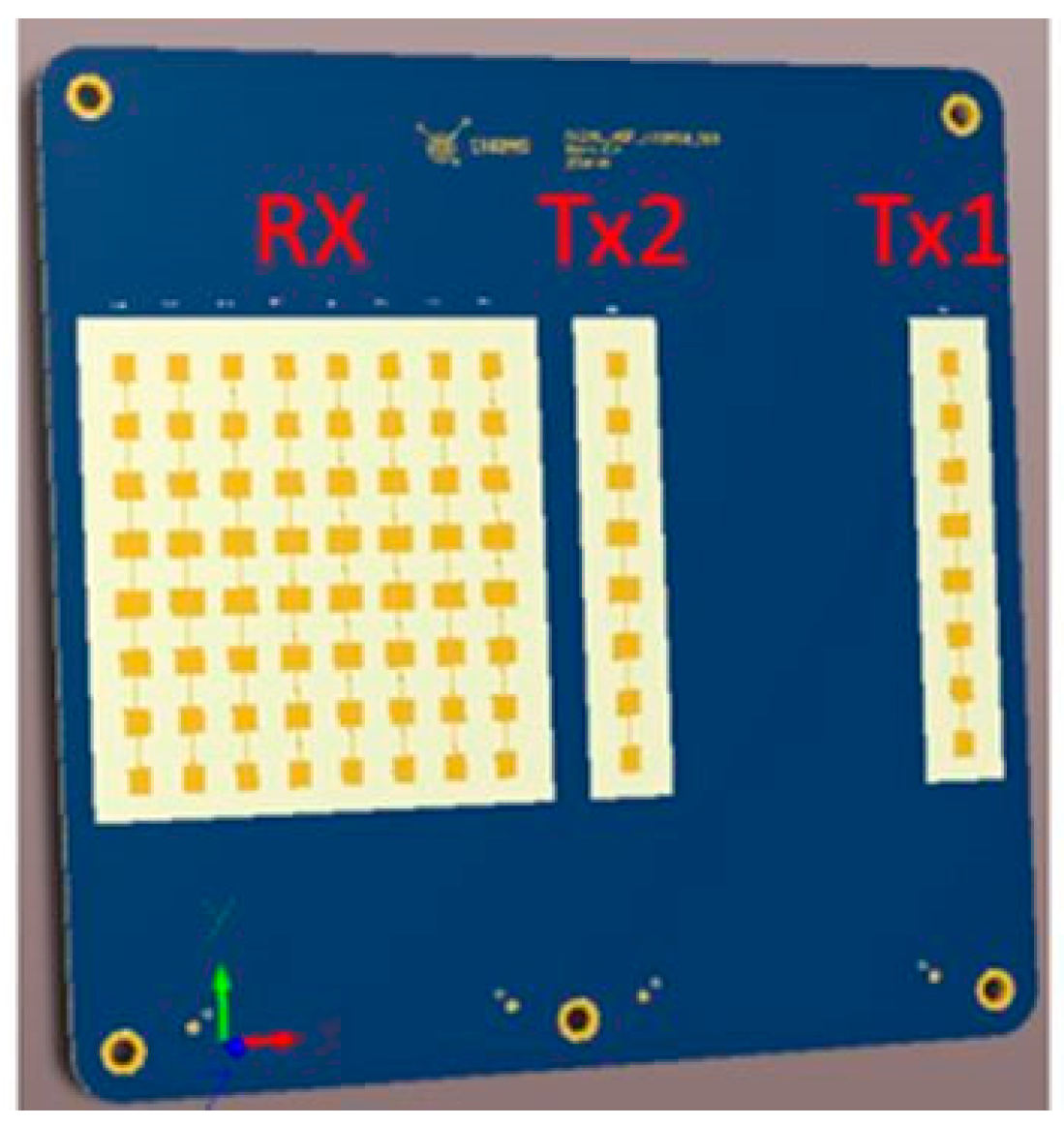

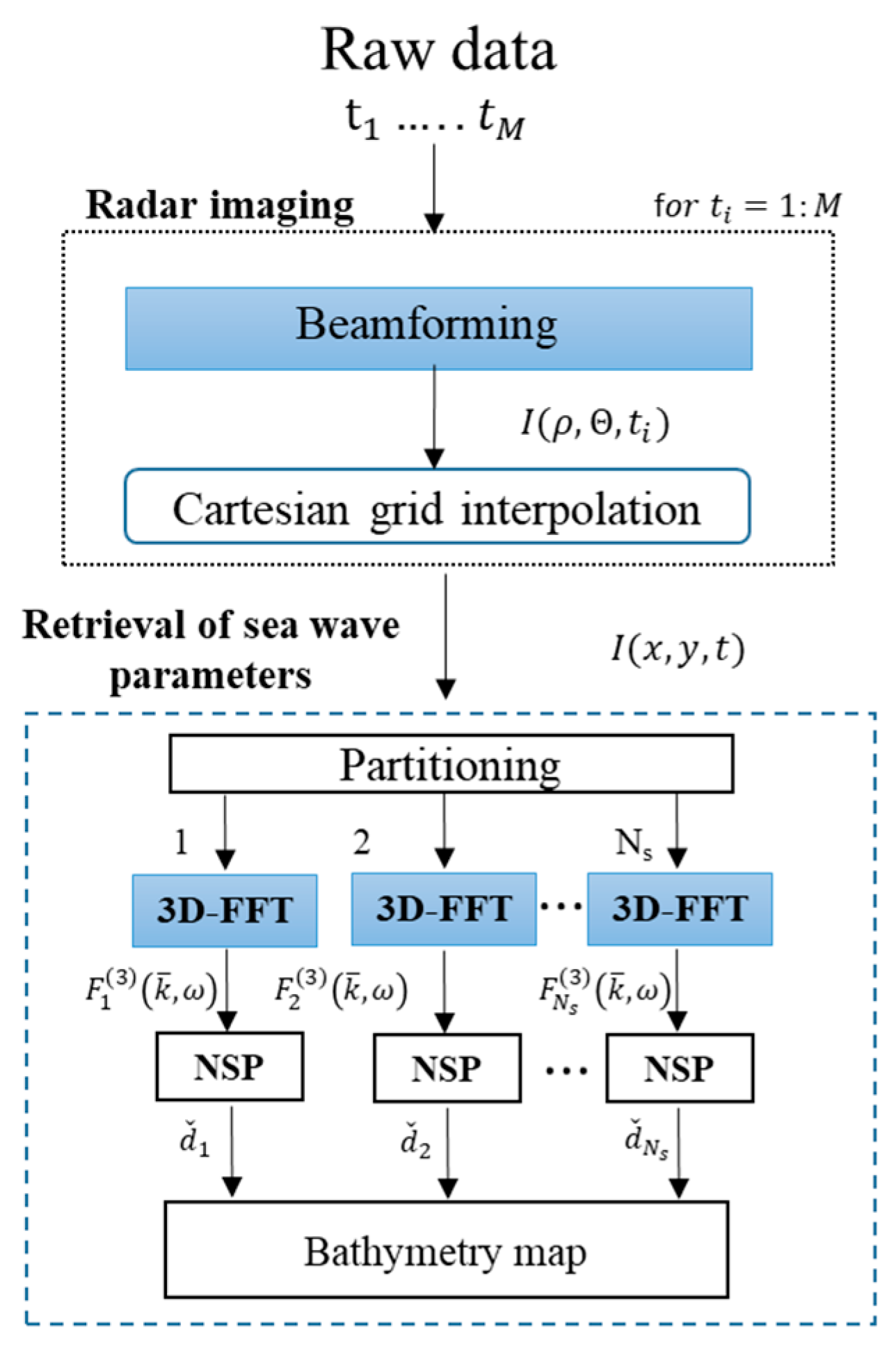

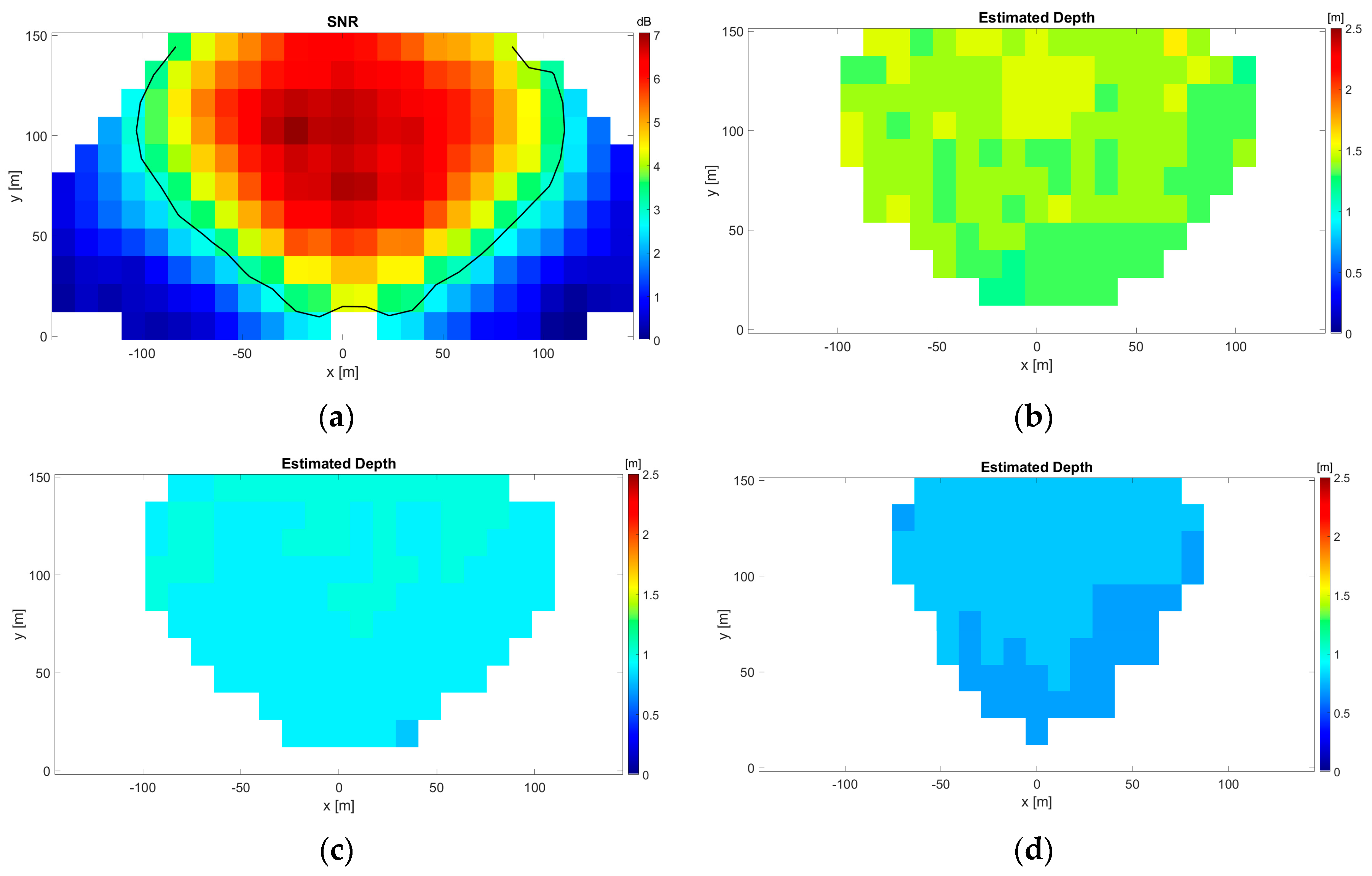


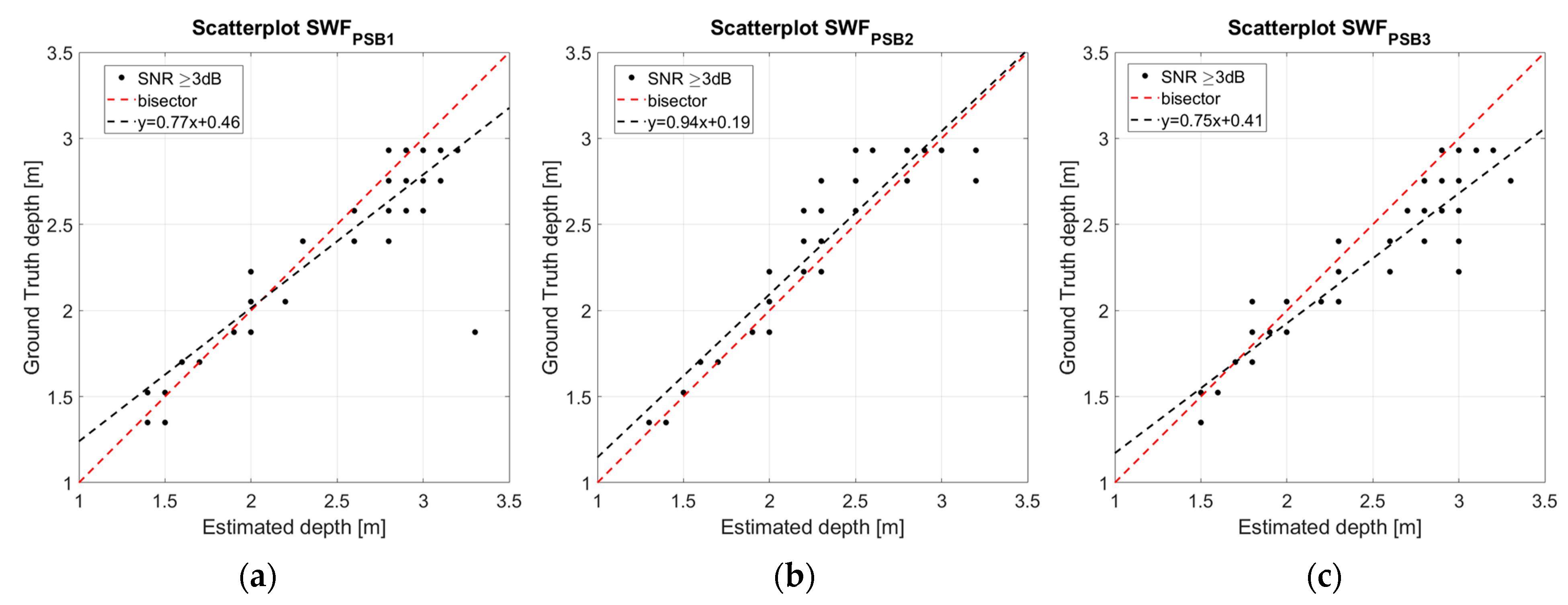
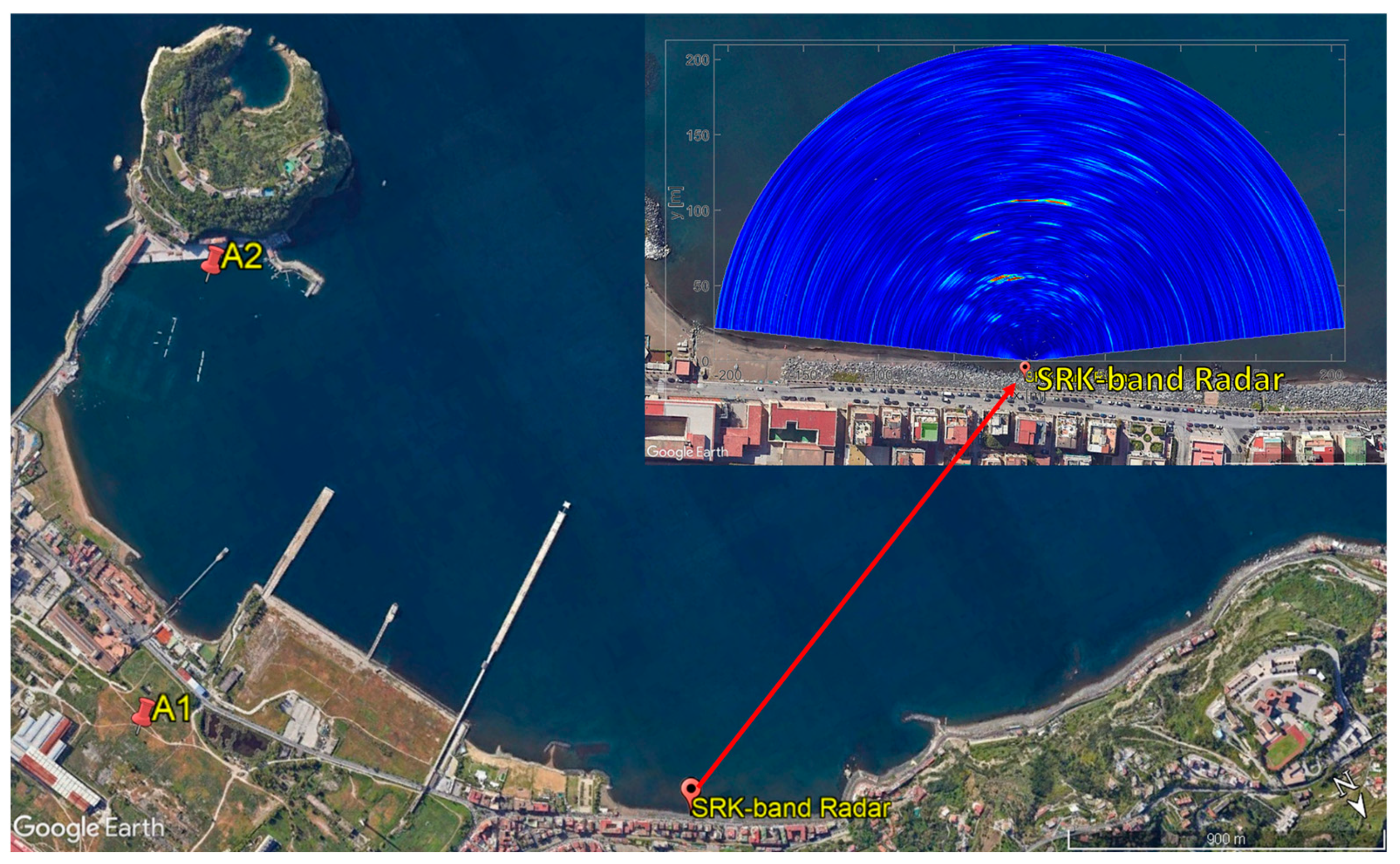


| SWF1 | 1.5 | 1.54 | 0.24 | 1.21 | 20 |
| SWF2 | 1.0 | 1.82 | 0.33 | 0.86 | 12 |
| SWF3 | 0.8 | 2.08 | 0.44 | 0.71 | 8 |
| Parameter | Description | Value | Unit |
|---|---|---|---|
| fstart | Min. frequency | 24.00 | [GHz] |
| fstop | Max. frequency | 24.25 | [GHz] |
| Tc | Chirp duration | 200 | [μs] |
| PRF | Pulse repetition frequency | 2 | [Hz] |
| Nt | No. baseband samples | 1024 | - |
| fs | Baseband sampling frequency | 5 | [MHz] |
| Tw | Observation time window | 128 | [s] |
| AzFov | Azimuthal FoV | 150 | [°] |
| H | Radar height (above MSL) | 10 | m |
| Min. range (above MSL) | 34 | m | |
| x | Max. range (above MSL) | 149 | m |
| SWF1 | 3.8 |
| SWF2 | 7.2 |
| SWF3 | 8.0 |
| SWFPSB1 | 1.3 | 0.25 |
| SWFPSB2 | 1.7 | 0.35 |
| SWFPSB3 | 2.1 | 0.45 |
| SWFPSB1 | 7.8 | 0.90 |
| SWFPSB2 | 5.6 | 0.91 |
| SWFPSB3 | 8.5 | 0.94 |
Disclaimer/Publisher’s Note: The statements, opinions and data contained in all publications are solely those of the individual author(s) and contributor(s) and not of MDPI and/or the editor(s). MDPI and/or the editor(s) disclaim responsibility for any injury to people or property resulting from any ideas, methods, instructions or products referred to in the content. |
© 2024 by the authors. Licensee MDPI, Basel, Switzerland. This article is an open access article distributed under the terms and conditions of the Creative Commons Attribution (CC BY) license (https://creativecommons.org/licenses/by/4.0/).
Share and Cite
Ludeno, G.; Antuono, M.; Soldovieri, F.; Gennarelli, G. A Feasibility Study of Nearshore Bathymetry Estimation via Short-Range K-Band MIMO Radar. Remote Sens. 2024, 16, 261. https://doi.org/10.3390/rs16020261
Ludeno G, Antuono M, Soldovieri F, Gennarelli G. A Feasibility Study of Nearshore Bathymetry Estimation via Short-Range K-Band MIMO Radar. Remote Sensing. 2024; 16(2):261. https://doi.org/10.3390/rs16020261
Chicago/Turabian StyleLudeno, Giovanni, Matteo Antuono, Francesco Soldovieri, and Gianluca Gennarelli. 2024. "A Feasibility Study of Nearshore Bathymetry Estimation via Short-Range K-Band MIMO Radar" Remote Sensing 16, no. 2: 261. https://doi.org/10.3390/rs16020261








